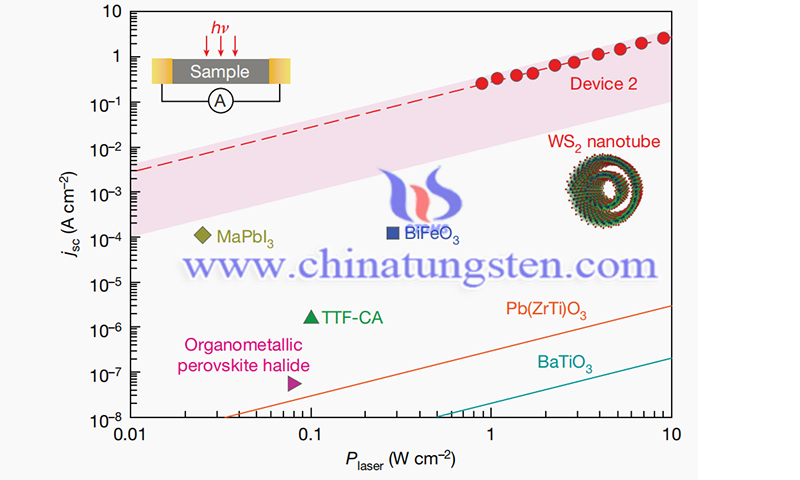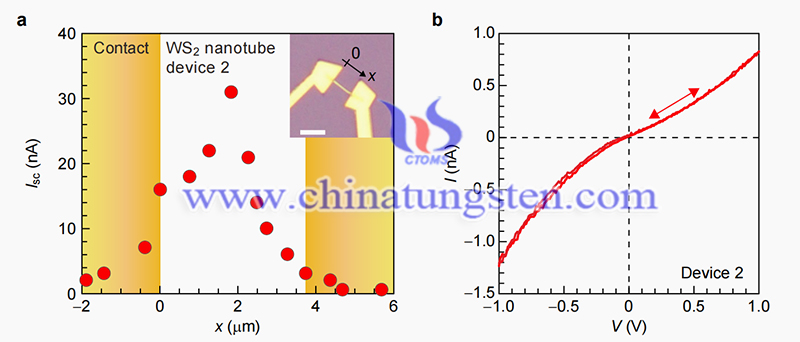Photovoltaic Effect of WS2 Bilayer Device Under Laser Illumination
- Details
- Category: Tungsten Information
- Published on Monday, 31 October 2022 21:28
The short-circuit current (Isc) under laser illumination is an important parameter for the evaluation of photovoltaic effects. We measured this current for WS2 bilayer device with different crystal symmetries. For each device, we scanned the laser spot from one electrode to the other to distinguish the BPVE from the Schottky barrier photovoltaic effect as well as the photothermal effect near the contact.
In the WS2 bilayer device, the PV response appears only when the contact point is irradiated by the laser, while no signal appears when only the WS2 sheet itself is irradiated. This is consistent with the symmetry required to observe BPVE. The single-layer device behaves similarly to the double-layer device, showing no significant PV response away from the contact point. Isc also remained small when the laser spot was fixed near the center of the WS2 sheet while rotating the linear polarization direction.

There are no symmetry-related arguments to prevent BPVE in monolayer devices under linearly polarized light, yet experiments clearly show that the amplitude, if present, is very small and buried in the photoelectric response generated by Schottky barriers and/or photothermal effects. In contrast, Isc in the WS2 nanotube device increases dramatically when the middle of the nanotube is illuminated.
Similar data for the second WS2 bilayer device, as well as a summary of the variation in BPVE amplitude in five different devices, show that the large increase in Isc away from the contact in nanotube devices cannot be explained simply by differences in the amount of light absorbed. Even though nanotubes may indeed absorb more light than monolayers due to their multi-walled nature, when we consider the size of the nanotube diameter with respect to the laser spot, the absorbed light intensity is at most twice that of the WS2 monolayer.
However, the observed differences in Isc between WS2 nanotube devices and WS2 monolayer devices reach several orders of magnitude. The reduction of crystal symmetry over mere non-central symmetry is clearly crucial. The lower crystal symmetry of nanotubes is also manifested in the study of the dependence of Isc on the linear polarization direction of the incident laser beam. For WS2 monolayers obeying the D3h point group symmetry, BPVE should drop to zero for a specific polarization direction of the incident light.

However, some studies could not resolve this dependence on the polarization direction, probably because BPVE is too small to be seen in the monolayer. In contrast, the mirror image and rotational symmetry are broken in nanotubes due to curvature, so that BPVE should persist in all linear polarization directions.
Cited paper: Zhang Y J, Ideue T, Onga M, et al. Enhanced intrinsic photovoltaic effect in tungsten disulfide nanotubes[J]. Nature, 2019, 570(7761): 349-353.
- Tungsten Manufacturer & Supplier, Chinatungsten Online: www.chinatungsten.com
- Tungsten News & Prices of China Tungsten Industry Association: www.ctia.com.cn
- Molybdenum News & Price: news.molybdenum.com.cn
- Tel.: 86 592 5129696; Fax: 86 592 5129797; Email: sales@chinatungsten.com



 sales@chinatungsten.com
sales@chinatungsten.com